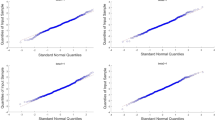Abstract
Weextend Wei and Tanner's (1991) multiple imputation approach insemi-parametric linear regression for univariate censored datato clustered censored data. The main idea is to iterate the followingtwo steps: 1) using the data augmentation to impute for censoredfailure times; 2) fitting a linear model with imputed completedata, which takes into consideration of clustering among failuretimes. In particular, we propose using the generalized estimatingequations (GEE) or a linear mixed-effects model to implementthe second step. Through simulation studies our proposal comparesfavorably to the independence approach (Lee et al., 1993), whichignores the within-cluster correlation in estimating the regressioncoefficient. Our proposal is easy to implement by using existingsoftwares.
Similar content being viewed by others
References
J. Buckley and I. James, “Linear regression with censored data,” Biometrika, 66, pp. 429–436, 1979.
B. Efron and R.J. Tibshirani, An Introduction to the Bootstrap, Chapman & Hall: London, 1993.
U. Hornsteiner and A. Hamerle, “A combined GEE/Buckley-James method for estimating an accelerated failure time model of multivariate failure times,” Discussion Paper 47, Ludwig-Maximillians-Universität München, 1996. Also available from http://stat.uni-muenchen.de/sfb386/publikation.html.
T. L. Lai and Z. Ying, “Large sample theory of a modified Buckley-James estimator in regression analysis with censored data,” Annals of Statistics, 19, pp. 1370–1402, 1991.
N. M. Laird and J. H. Ware, “Random-effects models for longitudinal data,” Biometrics, 38, pp. 963–974, 1982.
C. W. Lee, L. J. Wei, and Z. Ying, “Linear regression analysis for highly stratified failure time data,” Journal of the American Statistical Association, 88, pp. 557–565, 1993.
K.-Y. Liang and S. L. Zeger, “Longitudinal data analysis using generalized linear models,” Biometrika, 73, pp. 13–22, 1986.
T. A. Louis, “Non-parametric analysis of an accelerated failure time model,” Biometrika, 68, pp. 381–390, 1981.
C. A. McGilchrist and C. W. Aisbett, “Regression with frailty in survival analysis,” Biometrics, 47, pp. 461–466, 1991.
R. Miller, Survival Analysis, Wiley: New York, 1981.
W. Pan and C. Kooperberg, “Linear regression for bivariate censored data via multiple imputation,” Statistics in Medicine, 18, pp. 3111–3121, 1999.
W. Pan and T. A. Louis, “Alinear mixed-effects model for multivariate censored data,” Biometrics, 56, pp. 160–166, 2000.
D. B. Rubin, Multiple Imputation for Nonresponse in Surveys, New York: Wiley, 1987.
D. B. Rubin and N. Schenker, “Multiple imputation for interval estimation from simple random samples with ignorable nonresponse,” Journal of the American Statistical Association, 81, pp. 366–374, 1986.
A. A. Tsiatis, “Estimating regression parameters using linear rank tests for censored data,” Annals of Statistics, 18, pp. 354–372, 1990.
M. A. Tanner, Tools for Statistical Inference, Springer: New York, 1996.
M. A. Tanner and W. H. Wong, “The calculation of posterior distributions by data augmentation,” Journal of the American Statistical Association, 82, pp. 528–549, 1987a.
M. A. Tanner and W. H. Wong, “An application of imputation to an estimation problem in grouped lifetime analysis,” Technometrics, 29, pp. 23–32, 1987b.
G. Verbeke and E. Lesaffre, “The effects of misspecifying the random-effects distribution in linear mixed models for longitudinal data,” Computational Statistics and Data Analysis, 23, pp. 541–556, 1997.
G. C. G. Wei and M. A. Tanner, “Applications of multiple imputation to the analysis of censored regression data,” Biometrics, 47, 1297–1309, 1991.
L. J. Wei, “The accelerated failure time model: A useful alternative to the Cox regression model in survival analysis (with discussion),” Statistics in Medicine, 11, pp. 1871–1879, 1992.
Z. Ying and L. J. Wei, “The Kaplan-Meier estimate for dependent failure time observations,” Journal of Multivariate Analysis, 50, pp. 17–29, 1994.
Author information
Authors and Affiliations
Rights and permissions
About this article
Cite this article
Pan, W., Connett, J.E. A Multiple Imputation Approach to Linear Regression with Clustered Censored Data. Lifetime Data Anal 7, 111–123 (2001). https://doi.org/10.1023/A:1011334721264
Issue Date:
DOI: https://doi.org/10.1023/A:1011334721264



